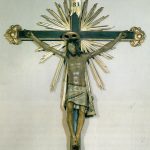The Crucifix is made of pear wood and painted, and it was restored in 1988 by Daniela Graglia on behalf of the Superintendency of Arezzo. At the time of the restoration, it was found to be severely damaged due to the layers of paint applied over the centuries and some mutilations. Preserved within the Propositura of Saints Hippolytus and Cassian, it was commissioned by the Company of the Crucifix of Laterina. It is a sculptural work of high quality, dating to the first or second decade of the 16th century, and is attributed to the workshop of Baccio da Montelupo.
The work is owned by the Company of the Crucifix and is only visible to the faithful during the annual feast held in September. On this occasion, it is traditionally carried in procession from the Propositura to the church of Santa Maria in Valle, where the miraculous image of the Virgin Mary is kept. The Company of the Crucifix is documented as early as around 1420, the year in which its original statutes are believed to have been written. It was suppressed in 1785 following the Leopoldine laws but was reconstituted in 1793.
The Crucifix is finely carved and modeled: the face is marked by strong, precise lines, and the hair is formed into a compact mass, with slightly wavy locks. The body is thin and sinewy, conveying the intense dramaticity of Christ’s passion. The arms are attached to the torso by two joints, allowing the sculpture to be adapted to the position of the Deposition of Christ as well.
Stylistically, the work shows some affinities with the crucifixes by Baccio da Montelupo, particularly in the poignant expression of the face, but it also shares similarities with the workshop of Benedetto da Maiano. Baccio had established a very active workshop between the late 15th and early 16th centuries, which was continued by his son Raffaello. The position of the legs and the head of the Latera crucifix are inspired by the Crucifixion at Sant’Onofrio, now housed in the Educatorio di Foligno. The face, however, recalls that of the Crucifixion at Villa La Quiete, which Baccio created in the last decade of the 15th century.
Manola Rosadini





